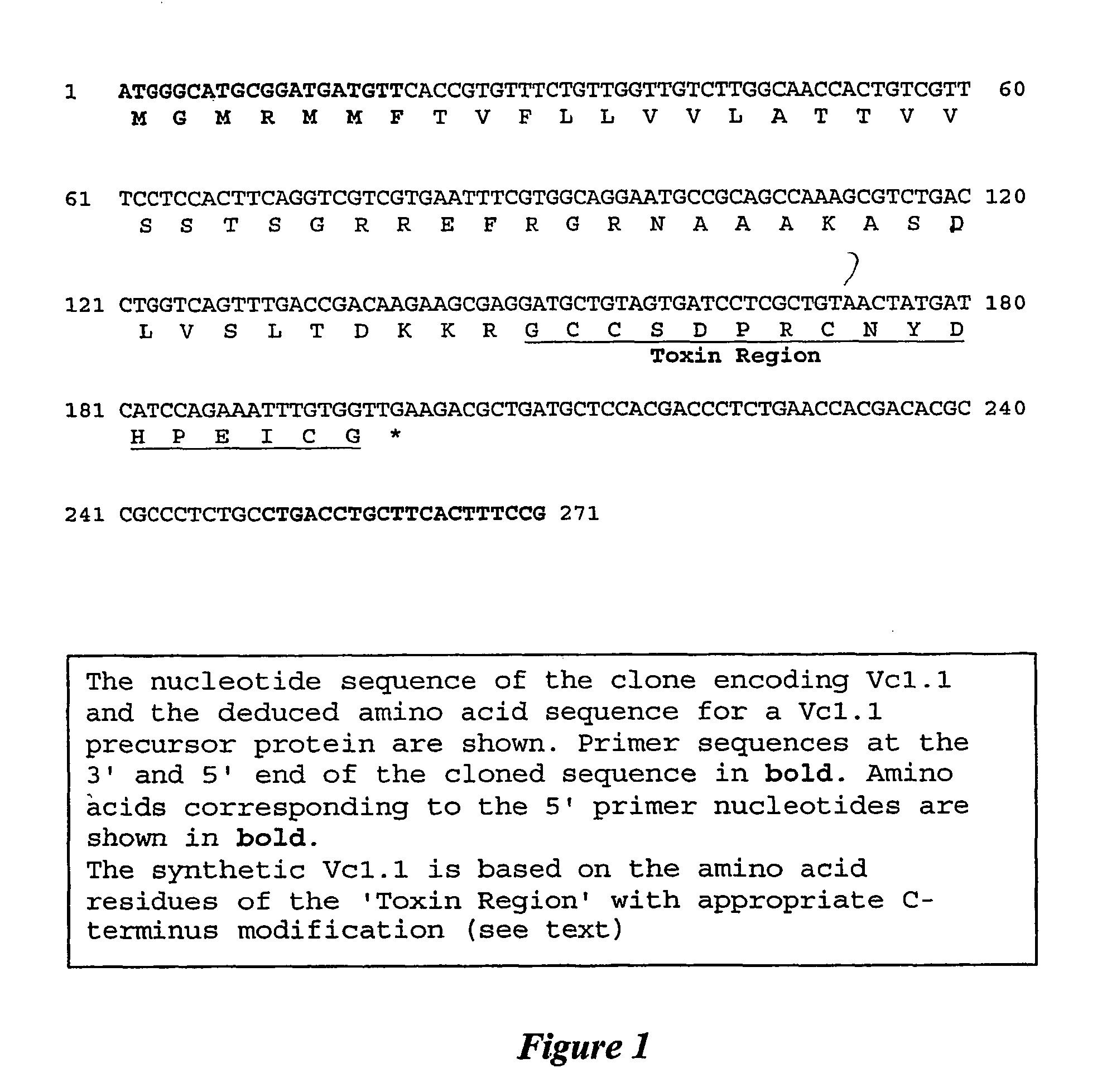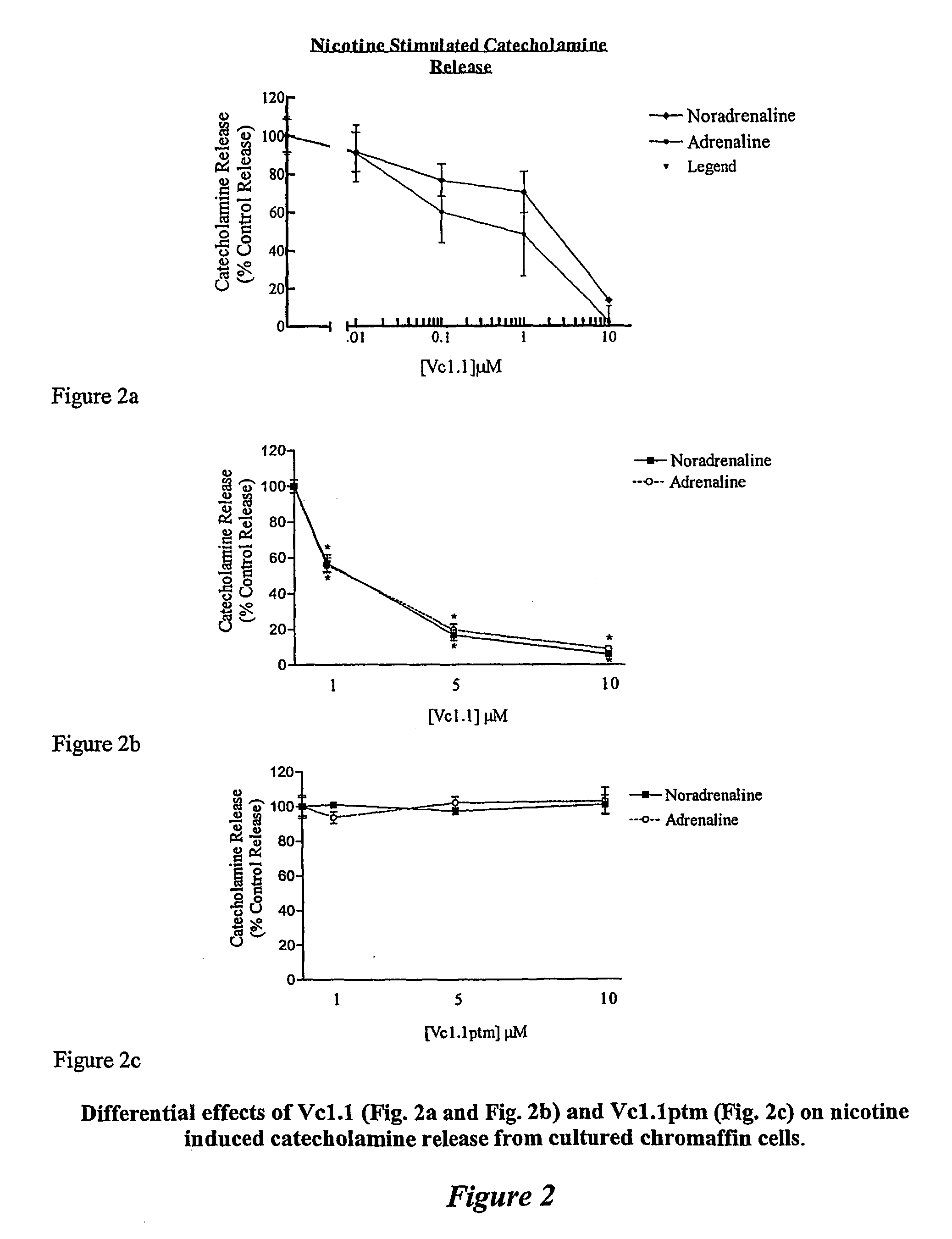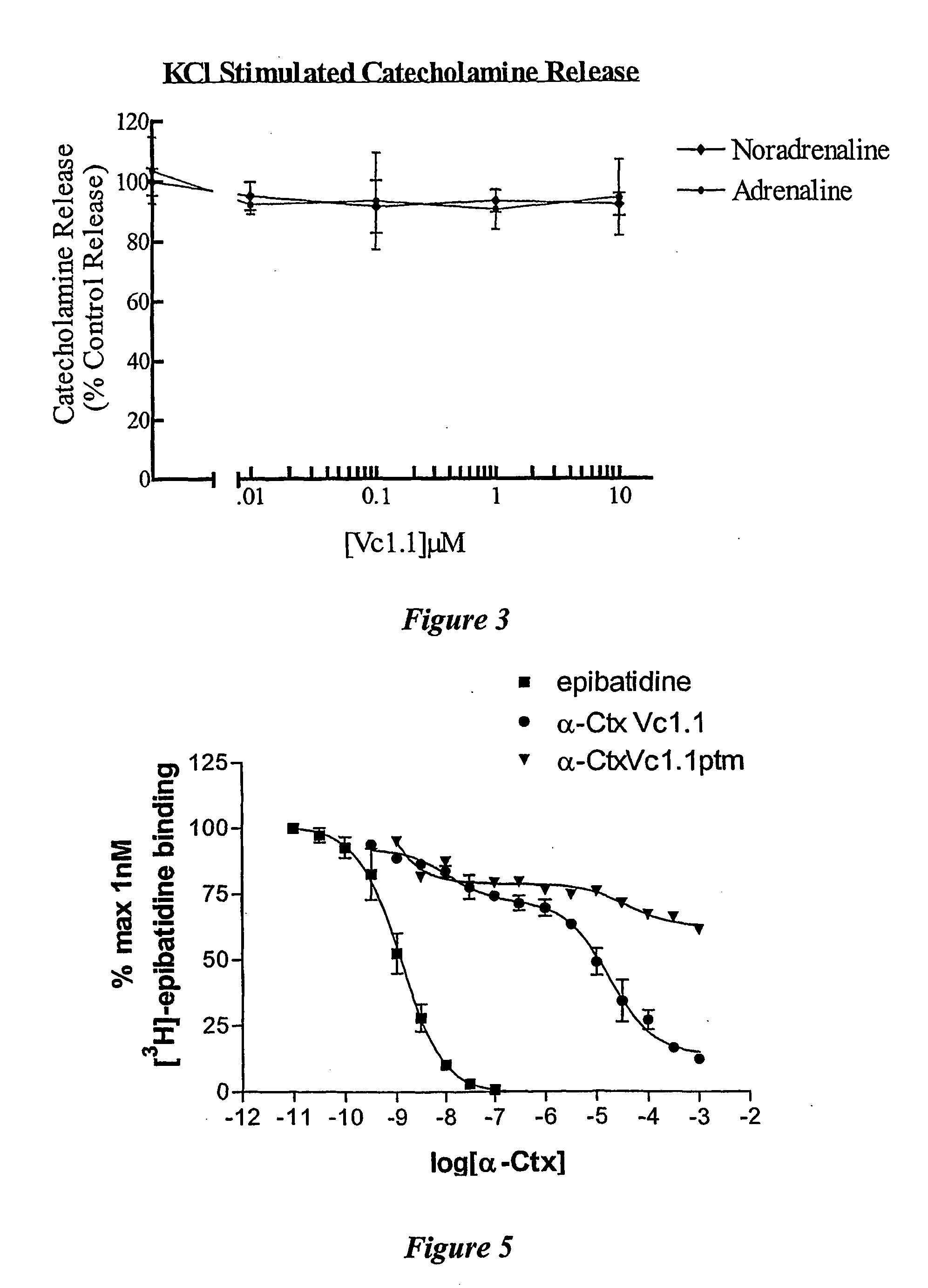Alpha conotoxin peptides with analgesic properties
a conotoxin and analgesic technology, applied in the field of alpha conotoxin peptides with analgesic properties, can solve the problems that members of the -conotoxin class still have undesirable side effects, and achieve the effects of not inhibiting the muscle-type nicotinic acetylcholine response, inhibiting sensory nerve activity, and reducing the inflammatory vascular respons
- Summary
- Abstract
- Description
- Claims
- Application Information
AI Technical Summary
Benefits of technology
Problems solved by technology
Method used
Image
Examples
example 1
Isolation of peptide Vc1.1
(a) mRNA extraction and cDNA synthesis
[0125] Specimens of the cone snail Conus victoriae were collected from Broome, Western Australia. The snails were part of the legal by-catch of a commercial fisherman, and approximately 20 snails were used. The venom ducts and bulbs of the cone snails were removed by dissection, before being snap-frozen in liquid nitrogen. Poly-A mRNA was extracted using a Dynabeads mRNA Direct Kit in accordance with the manufacturer's specifications. Double-stranded cDNA was prepared from the isolated mRNA utilising a Marathon™ cDNA amplification kit. First strand DNA was constructed utilising the Marathon cDNA synthesis primer and Moloney murine leukaemia virus reverse transcriptase. Second strand DNA synthesis was achieved using E. coli DNA polymerase, E. coli DNA ligase and E. coli RNase H. Blunt ended double stranded cDNA was prepared using T4 DNA polymerase.
(b) PCR Amplification of DNA Encoding Vc1.1
[0126] DNA encoding the V...
example 2
Peptide Vc1.1 Inhibits Nicotine-Evoked Catecholamine Release
[0137] Adrenal chromaffin cells were isolated from adult bovine adrenal glands as described by Livett et al., (1987a). Isolated cells were plated out on collagen coated 24-well plates at a density of 2.8×105 cells / cm2.
[0138] Three- to four-day old cultured chromaffin cells were allowed to equilibrate to room temperature for 5 mins. The incubation media was removed by two consecutive washes in Locke's buffer (154 mM NaCl, 2.6 mM KCl, 2.15 mM K2HPO4, 0.85 mM KH2PO4, 10 mM D-glucose, 1.18 mM MgSO4.7H2O, 2.2 mM CaCl2.2H2O, 0.5% bovine serum albumin, pH 7.4) for five mins. Cells were then incubated with various concentrations (0.01 μM, 0.1 μM, 1 μM, 10M) of the peptide Vc1.1 for five mins, before stimulation with either 4 μM nicotine or 56 mM KCl for a further five mins. The incubation mixture was separated from the cells and acidified with 2M perchloric acid (PCA) to give a final concentration of 0.4M PCA. The catecholamines ...
example 3
Vc1.1 Displaces 3H-epibatidine (a Nicotinic Receptor Agonist) from its Binding Site on the nAChR
[0142] Bovine adrenal glands obtained from the local abattoir were dissected and the medulla removed and placed into ice-cold 10% w / v 0.32M sucrose buffer, supplemented with 1 mM EDTA, 0.1 mM PMSF and 0.01% sodium azide. The medulla was homogenised using a Polytron homogeniser, and the homogenate centrifuged at 100 g for 10 minutes at 4° C. The resultant supernatant was decanted (S1) and the pellet resuspended in ice-cold sucrose buffer (5 ml / g of original medulla weight). This resuspended pellet was centrifuged at 100 g for 10 minutes at 4° C. and the supernatants S1 and S2 were combined and centrifuged at 12000 g for 30 minutes at 4° C. The resultant pellet was resuspended in 50 μM phosphate buffer (40 mM K2HPO4, 10 mM KH2PO4) containing 0.01% sodium azide, 0.1 mM PMSF and 1 mM bovine serum albumin and centrifuged at 12000 g for 30 minutes at 4° C. This step was repeated and the washed...
PUM
| Property | Measurement | Unit |
|---|---|---|
| pH | aaaaa | aaaaa |
| pH | aaaaa | aaaaa |
| concentration | aaaaa | aaaaa |
Abstract
Description
Claims
Application Information
 Login to View More
Login to View More - R&D
- Intellectual Property
- Life Sciences
- Materials
- Tech Scout
- Unparalleled Data Quality
- Higher Quality Content
- 60% Fewer Hallucinations
Browse by: Latest US Patents, China's latest patents, Technical Efficacy Thesaurus, Application Domain, Technology Topic, Popular Technical Reports.
© 2025 PatSnap. All rights reserved.Legal|Privacy policy|Modern Slavery Act Transparency Statement|Sitemap|About US| Contact US: help@patsnap.com



